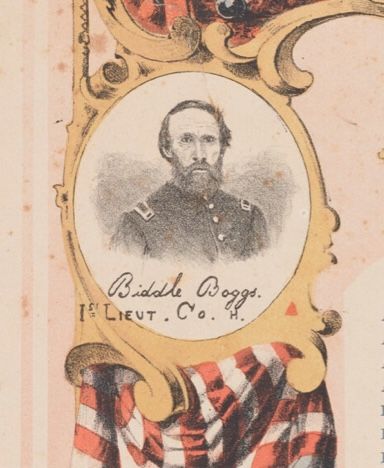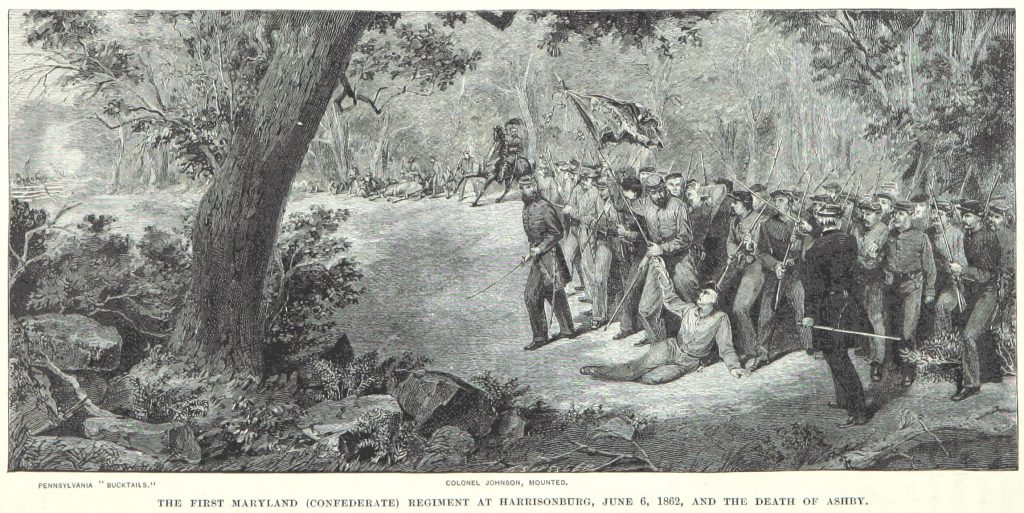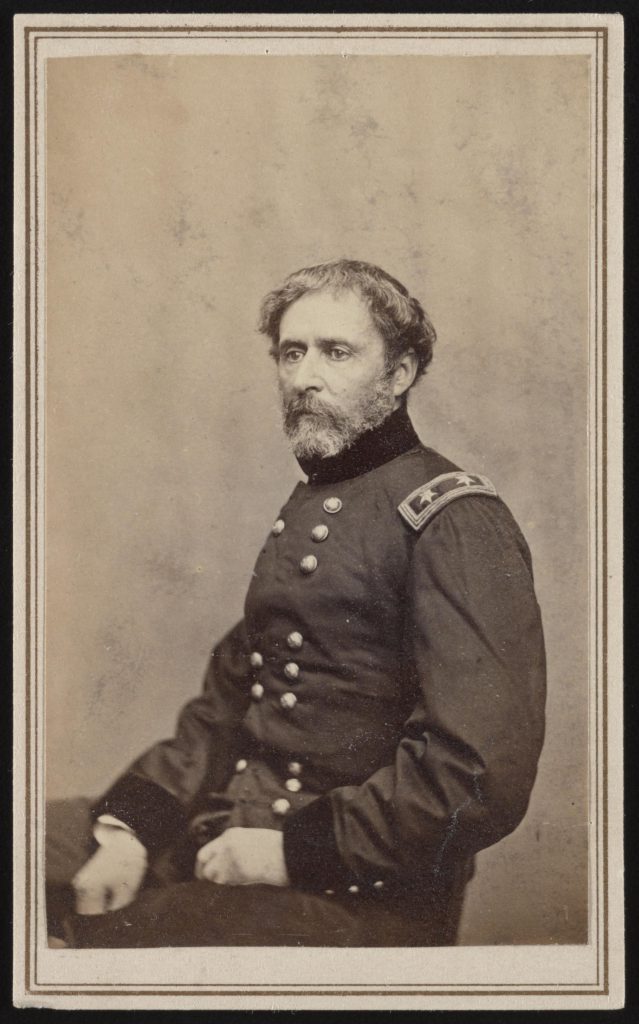Research Arsenal Spotlight 20: Biddle Boggs, Lt. on Gen. John C. Frémont’s Staff

Biddle Boggs was a rather unique character in history, serving in both the Mexican-American War and the Civil War. He was born in 1822 to Andrew Boggs and Sarah Talman (Biddle) Boggs of Saltsburg, Pennsylvania.
In the 1850s, Biddle Boggs came to California and was a close friend and associate of John C. Frémont, who he frequently mentioned in his letters and much admired. At the time Biddle Boggs was in a legal battle on behalf of mineral rights on Mt. Ophir against Merced Mining Company, a fight he was making covertly on the behalf of John C. Frémont’s interests. In a letter written September 12, 1856, he informed his sister of his current employment:
“I am now working for Col. Frémont and have been since last April. I have charge of some rich quartz veins. They are not working them now so I have nothing to do. Well, there is nothing like working for a President though I have not had but twenty-five dollars since last April. They pay my board so I do not need money at present and don’t spend any. I am saving up to go home.”
Biddle Boggs and the Civil War

After attempting to obtain a commission in the winter of 1861, Biddle Boggs was finally accepted into service as Quartermaster Agent in February, 1862, in Cincinnati, Ohio. In April, 1862, General John C. Frémont had him transferred to his staff in the Mountain Department in Wheeling, Virginia.
On June 14, 1862, Biddle Boggs wrote a letter to family telling them of the recent exploits of General John C. Frémont’s forces, including the death of the Confederate General Turner Ashby at Good’s Farm. Biddle Boggs had a close call of his own, as he related in the letter:
“I received your letter some days ago and would have answered it sooner but have been busy fighting. All our boys came out safe. I had my horse killed under me with a shell. It went through his hips & into the ground on the other side, but did not explode. I was not hurt. Monroe & Tom were in the thick of the fight but none of their company were killed or wounded. Our loss in killed & wounded was about 500 or 600. I do not know the enemy’s loss—supposed 1200. We drove them across the river; they burnt the bridge so we could not follow them. So we fell back to this place to get supplies as we fought them on our last ration. We killed their famous Col. Ashby—or rather General Ashby—and many of their officers. We counted 200 of them killed in one field.”
Biddle Boggs also discovered that he had family fighting in the Confederate army.
“I have been back with a flag of truce to Harrisonburg [Virginia] (they occupy that place with their cavalry since we came down the valley to this place) and had quite a talk with some of the rebel officers. They told me they knew cousin Frank J. Boggs. He is a major in the rebel army at Richmond now. So you see, we have kin on the other side.”
Biddle Boggs closed with a grimly optimistic note that his family shouldn’t worry about him eating as “there is plenty of dead horses if nothing else” and for the moment they had “plenty of beef, have bread, coffee, & rice now and plenty on the land.”
Biddle Boggs and the 80th US Colored Troops Infantry
In May, 1863, Biddle Boggs was in Baton Rouge, Louisiana. He was now a lieutenant what would become the 80th US Colored Troops Infantry. The regiment was under the command of Colonel Cyrus Hamlin, who was a son of Vice President Hannibal Hamlin and, like Biddle Boggs, Cyrus Hamlin had also been serving on the staff of General John C. Fremont. One of the soldiers in the regiment, Corporal Henry Demas of Company H, after the war became one of Louisiana’s longest serving African American politicians, serving as both a state house representative and later a senator from 1870 to 1892.
One May 18, 1863, Biddle Boggs wrote a letter to his sister detailing the recruitment for the regiment and the ongoing siege of Port Hudson, which he believed would soon come to an end. In actual fact, the siege lasted until July 9.
“You see I am down south and on the Mississippi River. We are about 25 miles below Fort [Port] Hudson which is yet in the hands of the Rebels. Our gunboats & mortar boats have been humming at them every day for a while & almost every night for 2 or 3 hours since the 8th of this month. We—from our camp—can hear it quite plain. Some nights they fire so heavy, it wakens me up. We can see the bombs when they burst up in the air and see the flashes of the cannon on dark nights. This is just near enough to be comfortable, but it must break the rest of the Rebels and keep them awake. I do not know how many have been killed or wounded or whether any of our side. I have not heard of any.
We are getting some recruits for our regiment (200 now). We will take Port Hudson this week. Then we will be able to get recruits faster as they can get in from up the river. I hear the cannon at Port Hudson 8 o’clock a.m. They have just commenced. Let them bomb away.”
Biddle Boggs and John C. Frémont

On March 10, 1864, Biddle Boggs was still serving as a 2nd Lieutenant in Company H, of the 80th US Colored Troop Infantry, which at that time was known as the 8th Regiment Corps d’Afrique. He wrote a letter to his brother-in-law, Joseph Wheldon, which revealed his continued close connection with John C. Frémont:
“I had a letter from Mrs. Frémont wishing me to go to New Orleans to see the General’s niece, Miss Nina Frémont, who was there to see her mother. Mrs. General Banks called and took her to a ball on the 4th. I went also. It was a big affair—too large for me, but I held my hand with the best of them and went them some better.”
In the same letter Biddle Boggs also expressed his hopes that John C. Frémont would receive a presidential nomination in the upcoming election:
“I have nothing to write about. I hope the Republicans will nominate Frémont for next President and elect him. I find he has many friends in the Army who think he is the man for the times, and think also that he ought to have a command and would be glad to serve under him. We want men of energy and he has.”
The final letter by Biddle Boggs in our collection was written July 11, 1865. The letter opens with a full circle moment for Biddle Boggs, once again at place in his military service where he had been 20 years previously during the Mexican-American War and at a new milestone in his career:
“Here we are “Lou” and I on “Red River” at the place I swam it in 1846 on my way to Mexico. Our regiment is stationed here doing post duty. I am A. R. Quarter Master & Ordnance Officer of the post. Received my commission as First Lieutenant in 80th Colored Troops from Washington City today.”
The “Lou” referred to in the passage was Biddle Boggs’ wife, Mary Louise (Hayward) Boggs, whom he married in 1864 in Louisiana.
Biddle Boggs concluded his letter with a short note about the recent execution of the conspirators in the Lincoln assassination:
“Hurrah for Andy Johnston for hanging Mrs. Surratt and all other assassins. It saves trouble and sends witches where they belong—to Old Nick. Who would want to be in Heaven with assassins.”
Biddle Boggs died in 1886 and was buried at Ferncliff Cemetery.
We’d like to give a special thanks to William Griffing of Spared & Shared for sharing and transcribing these letters.
To read all of Biddle Boggs’ letters and access thousands of other Civil War letters and documents, sign up for a Research Arsenal membership.
If you enjoyed this article, check out some of our other recent collection spotlights, like Varnum Valentine Vaughn of the 53rd Massachusetts Infantry and George P. Jarvis of the 3rd Ohio Infantry.

